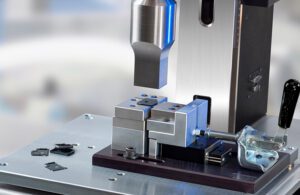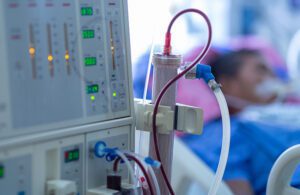The move toward polypropylene and polyethylene in medical devices requires new manufacturing and assembly solutions such as ultrasonic and laser welding.
Didier Perret, Emerson

Emerson’s Branson GSX Ultrasonic Welding Platform [Photo courtesy of Emerson]
Plastics are ubiquitous in medical applications thanks to their light weight, durability and flexibility, among other attributes. However, concern has been increasing in recent years about the possible negative effects of some ingredients and components in certain plastics. This is leading medical-device companies to research and use other resins or combinations of plastics without the same risks. However, they do not have the same processing characteristic, and the changes often require companies to implement new production processes, especially around assembly and joining technologies.
For instance, polyvinyl chloride (PVC) is used in 40% of all plastic-based medical devices, according to Brussels-based PVCMed Alliance , and most tubing and IV bags available today, as well as many masks, breast-pump kits, catheters and more. Yet dioxin, a known human carcinogen, can form during the manufacture of PVC, and toxic chlorine may be released during processing and assembly. In addition, DEHP, a phthalate plasticizer commonly used to soften PVC, is a known endocrine-disrupting compound that is feared to leach into a patient’s bloodstream and potentially cause fertility problems and other reproductive-related issues. For these reasons, healthcare and professional organizations including the American Medical Association, among other encourage hospitals and physicians to reduce and phase out the material.
Joining PVC components
The vast majority of PVC bags and other components are assembled using conductive (heat) welding, radio-frequency (RF) welding — also known as high-frequency or dielectric welding — as well as solvent welding and adhesives. As manufacturers have begun to explore alternative materials, particularly polyolefins such as polypropylene (PP) and polyethylene (PE), they are finding these traditional joining techniques are not effective, while other technologies offer cost reductions, sustainability improvements and safer toxicology for the product and along the entire production process.
PP and PE are nonpolar polymers, so they are impervious to the electromagnetic waves that generate heat during RF welding. Likewise, PP and PE have excellent chemical resistance and are not easily bonded using solvents, and their low surface energy also means adhesives are not very effective.
By far the most effective technology for assembling polyolefins, as well as multilayer films incorporating these and other materials to form IV bags, is ultrasonic welding. Ultrasonic welding uses high-frequency vibrations to generate frictional heat between layers, softening the plastic so it merges into a high-quality seal when the films are held together under pressure. This is an extremely fast joining process that can be applied to almost any thermoplastic, including PVC. While the equipment costs are higher than other technologies, there are numerous benefits that ensure a relatively quick return on investment:
- Energy savings: Unlike conductive welding, tooling does not need to be preheated and remains cool when not in use.
- No consumables: Adhesives and solvent are not required.
- Process efficiency: Welding times are short, allowing more cycles per minute.
- Nontoxic: No off-gassing occurs during welding, so there is no danger to operators and no need for expensive venting equipment.
- Green: All these factors contribute to a smaller carbon footprint than any competing joining method, including solvents or gluing.
Replacing polycarbonate

A kidney dialysis machine [Photo courtesy of Emerson]
Polycarbonate (PC) is very strong, clear and dimensionally stable, making it ideal for many healthcare applications, including the tubular filter housings that are key components in kidney dialysis systems. However, it is known to contain bisphenol-A (BPA), another known endocrine-disrupting chemical that — like DEHP — can potentially cause a range of adverse health effects. It has largely been eliminated from use in baby bottles and water bottles used by athletes, and activist groups continue to call for an outright ban.
One of the reasons PC has not been totally banned is because low levels of BPA that find their way into the human body are easily eliminated by normal kidney function. However, according to recent studies, serum BPA levels accumulate as renal function decreases, and are highest in individuals with chronic kidney disease who are on hemodialysis. Hence, in dialyzer applications, manufacturers are looking for alternatives such as polypropylene.
Unfortunately, many of the limitations of PP as a replacement for PVC also apply to PC applications. Polycarbonate dialyzer housings have historically been assembled using mechanical fasteners and adhesives, neither of which works well considering the lower yield strength and lower surface energy of PP.
Consequently, manufacturers are here too turning to ultrasonic welding (with all the attendant benefits detailed above), as well as laser welding. In this latter process, components are pre-assembled before welding, and no vibration or movement is required to produce clean, particulate-free welds. Multiple laser beams apply energy along the full length of weld surface. One surface freely transmits the laser energy without itself being affected through to the second, laser-absorbing surface where laser energy is converted to heat conducted across the interface, creating the weld. Benefits of this process include:
- Weld quality: Localized heating/melting develops excellent cosmetic properties.
- Minimal flash and no particulate: No frictional motion and accurate power dissipation.
- Part design flexibility: Multidimensional joint configurations are possible.
- Gentle: There’s no vibration, and minimal heating protects sensitive components.
- Fast and flexible: Ideal for high-volume applications.
Where to turn for help
As the industry turns from traditional materials like PVC and polycarbonate to cheaper, safer PP and PE, manufacturers are finding they can simplify their products, reduce costs and improve performance by shifting to ultrasonic or laser welding.
If you are seeking a new assembly solution to respond to market pressures that dictate a change in material, if you are seeking a new, more productive solution to your assembly needs, or even if you are already using ultrasonic and/or laser welding systems, Emerson and its Branson brand of products can offer support and assistance. Emerson takes a process-neutral approach to recommend the right technical solution for each application, and can make transitions as smooth as possible. Every Branson welding solution is backed by deep technical knowledge, decades of application experience, and a global supply chain with strong sourcing, manufacturing and customer-support capabilities.

Didier Perret [Photo courtesy of Emerson]
Didier Perret is the medical business development manager, Branson Welding and Assembly at Emerson. He has a degree in mechanical engineering from Technicum La Chaux-de-Fonds in Switzerland. Perret has worked for Emerson since 2000 and has extensive experience in automation, production, product design and plastics assembly technologies.
The opinions expressed in this post are the author’s only and do not necessarily reflect those of MedicalDesignandOutsourcing.com or its employees.